Gardening enthusiasts often face a tough choice: disrupting the soil or letting nature take its course. While many still rely on conventional practices, others embrace a gentler approach. The debate between these two techniques has grown, especially as sustainability gains importance.
Did you know 63% of U.S. gardeners continue to till, despite environmental concerns? Meanwhile, farmers adopting alternative methods report surprising benefits—like saving up to 3.5 gallons of fuel per acre. The USDA notes a 35% increase in no-till adoption since 2012.
Your decision depends on factors like soil type, climate, and long-term goals. Smaller gardens may thrive with minimal disturbance, while larger plots might need occasional turning. Ruth Stout’s straw method, for example, proves that working with nature can yield impressive results.
Ready to explore which approach suits your space? Let’s break down the key differences.
Understanding No-Till and Traditional Tilling
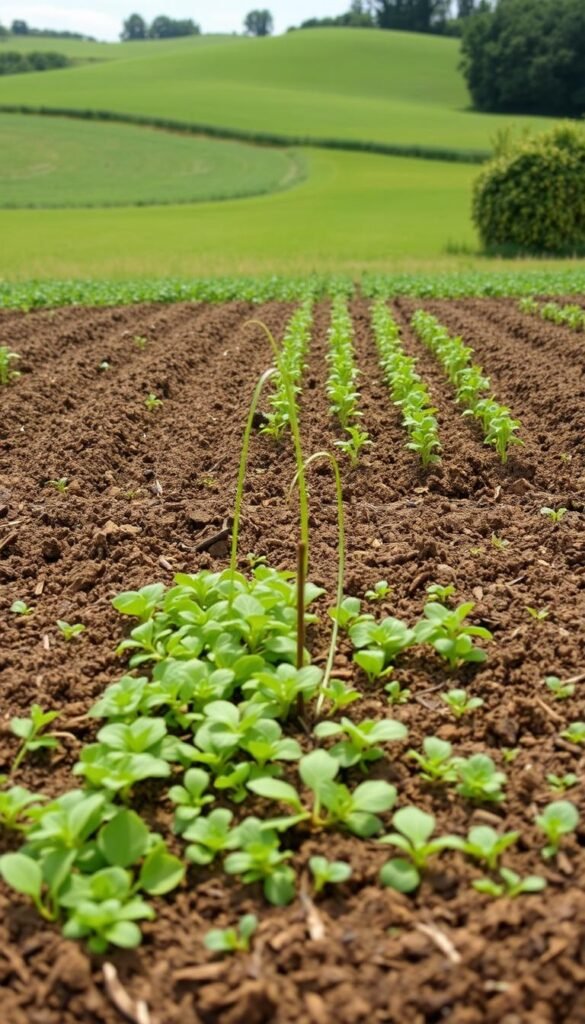
Soil management techniques shape your garden’s future in surprising ways. Whether you prioritize sustainability or immediate results, grasping these approaches helps you make informed choices. Let’s explore their core principles.
What Is No-Till Gardening?
This method avoids turning the earth, preserving its natural layers. Specialized disc seeders plant directly into untouched soil, protecting microbes and roots. Soil aggregation remains intact, boosting water retention.
“No-till systems can sequester 0.3 tons of carbon per acre annually.”
What Is Traditional Tilling?
Conventional tillage inverts the top 6–12 inches of soil, burying weeds and aerating the ground. It requires multiple passes—first to break the earth, then to plant. While effective for short-term weed control, it reduces soil structure by up to 60%.
Key Differences at a Glance
| Factor | No-Till | Traditional Tilling |
|---|---|---|
| Equipment Cost | $2,500+ (no-till drill) | $300 (rototiller) |
| Soil Disturbance | Minimal | High |
| Cover Crops | Yes (organic options) | Yes, but less common |
Both methods can use cover crops to enrich the earth. Contrary to myths, no-till doesn’t demand GMO seeds—organic alternatives work perfectly. Your choice hinges on balancing immediate needs with long-term soil health.
How No-Till and Traditional Tilling Affect Soil Health
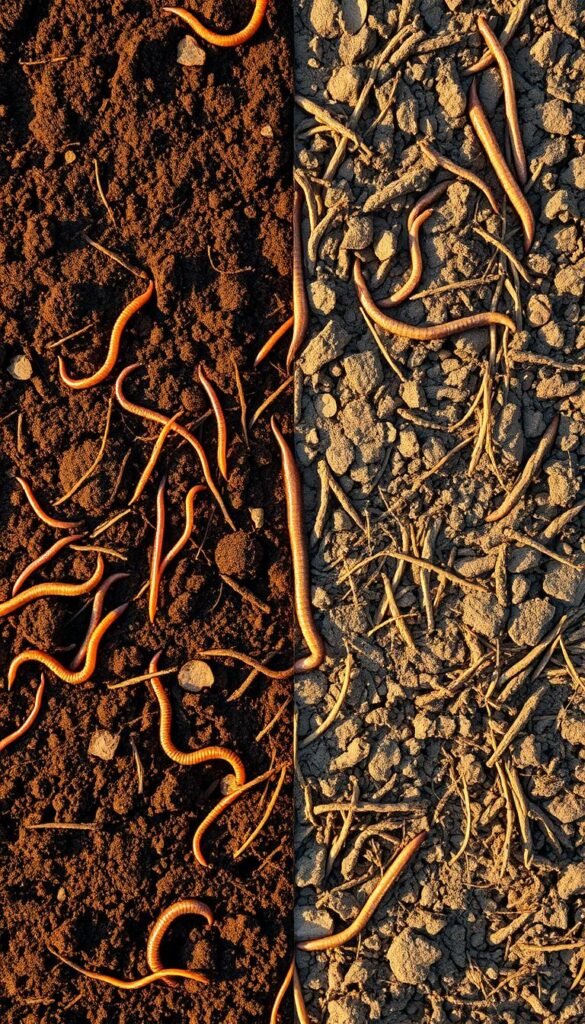
Healthy soil is the foundation of a thriving garden. The way you treat it determines everything from plant growth to water retention. Let’s examine how these two methods impact the ground beneath your feet.
Preserving Soil Structure and Microbes
Leaving soil undisturbed protects its delicate ecosystem. Studies show a 71% increase in microbial biomass in untouched earth. Earthworm populations triple, creating natural tunnels for roots and water.
Fungi networks thrive, connecting plants and sharing nutrients. These invisible helpers boost resilience against drought and disease. Organic matter builds up over time, locking in moisture and carbon.
“Undisturbed soil holds 30% more water during dry spells, reducing irrigation needs.”
Aeration vs. Disruption
Turning soil does provide short-term benefits. It breaks up compacted layers and mixes in amendments quickly. However, this comes at a cost—tilling reduces fungal networks by 80% initially.
Iron availability spikes temporarily, but long-term nutrient cycling suffers. The process exposes buried weed seeds to sunlight, triggering new growth. Each pass with equipment further degrades soil structure.
Long-Term Soil Quality Comparison
After years of practice, the differences become striking. Check how these methods stack up:
| Factor | Undisturbed Soil | Tilled Soil |
|---|---|---|
| Water Absorption | 2.5 inches/hour | 0.8 inches/hour |
| Carbon Storage | +1.2 tons/acre/year | Neutral or loss |
| Erosion Resistance | 60% better | High risk |
Clay soils need special attention—compaction can occur without proper no-dig techniques. Adding organic mulch helps maintain balance while improving texture.
Your gardening goals determine the best approach. Want immediate results with higher maintenance? Traditional methods work. Prefer building resilience over time? Undisturbed systems deliver.
No-Till vs. Traditional Tilling: Impact on Plant Yields
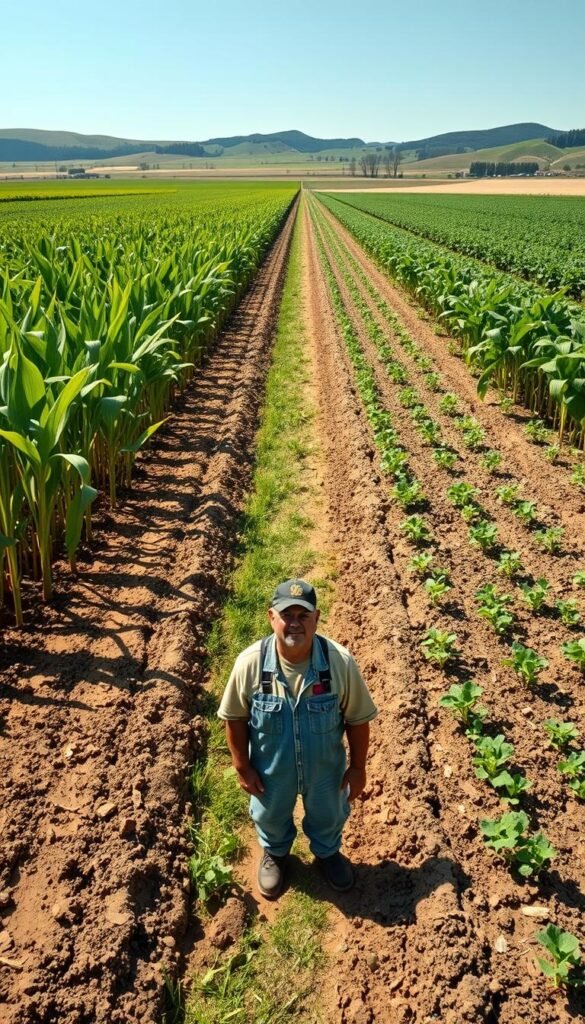
Your garden’s productivity hinges on how you treat the soil beneath it. While short-term results might favor one approach, long-term gains often tell a different story. Let’s explore how these methods compare across crops, climates, and seasons.
Crop Performance in No-Till Systems
Undisturbed soil takes time to reach its full potential. For example, maize yields drop 7.6% initially in no-till systems, but rebound as microbial life stabilizes. Tomatoes follow a similar pattern—averaging 24 lbs per plant in the first three years, compared to 28 lbs with tilling.
Patience pays off. USDA research shows the yield gap narrows to 5.1% after five, with some crops surpassing traditional methods. Drought-prone areas see an 18% advantage with rainfed no-till, thanks to better water retention.
Yield Results with Traditional Tilling
Turning soil delivers immediate rewards. Root crops like carrots produce 22% more with deep tilling, while brassicas (e.g., cabbage) resist clubroot disease better in worked earth. Cold climates benefit too—tilling allows planting two weeks earlier by warming the soil faster.
However, these gains come with trade-offs. Tilled plots require 30% more water in arid zones and lose topsoil over time. The initial nutrient surge fades, leaving plants dependent on added fertilizers.
Climate and Regional Variations
Your location dramatically influences outcomes. Consider these regional trends:
| Region | No-Till Advantage | Traditional Tilling Benefit |
|---|---|---|
| Midwest | Higher drought resilience | Limited early-season gains |
| Northeast | Slower initial growth | Faster spring warm-up |
| Southwest | Reduced irrigation needs | Poor long-term soil health |
“No-till systems in the Corn Belt matched conventional yields within 4–7 years while cutting erosion by 90%.”
For tailored advice, explore no-dig techniques suited to your soil type. Whether you prioritize quick harvests or sustainable growth, understanding these patterns helps you maximize every season.
Labor and Cost Considerations
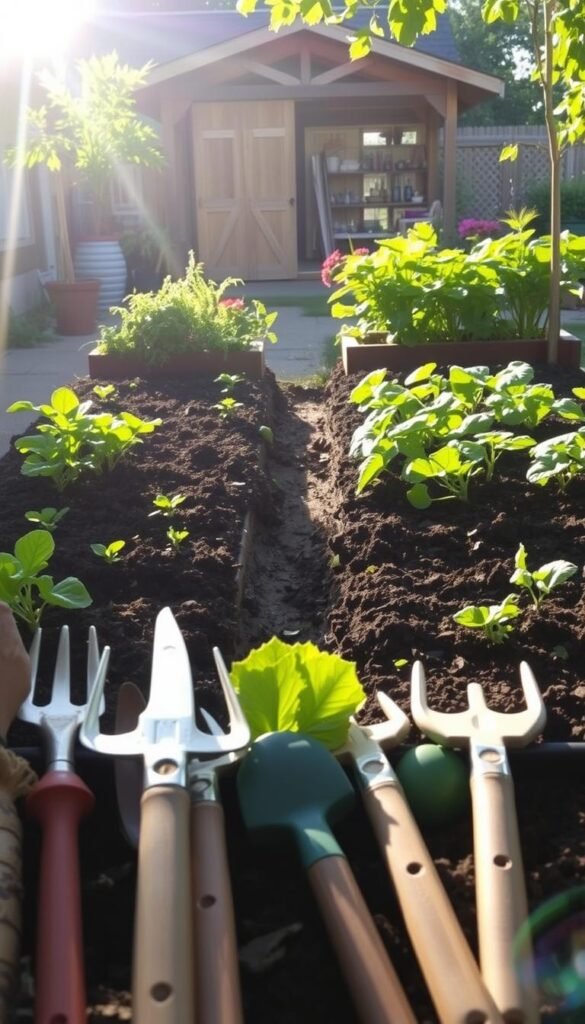
Smart gardeners know that time and money matter just as much as soil quality. While one approach might seem cheaper upfront, hidden expenses and labor hours can change the equation. Let’s break down what each method demands from your schedule and wallet.
Time Investment: No-Till’s Efficiency
Undisturbed beds save countless hours annually. Research shows a 60% reduction in labor compared to conventional tillage. Instead of spending 22 hours per acre turning soil, you might only need 8 hours for mulching and planting.
The secret lies in reduced maintenance. Earthworms aerate the soil naturally, while mulch suppresses weeds. Over a five-year period, these savings add up to 300+ hours for a modest half-acre plot.
“No-till adopters report 5.5 gallons of fuel savings per acre annually, cutting both time and energy costs.”
Equipment Needs for Traditional Tilling
Rototillers dominate conventional setups, ranging from $200 for small models to $800 for commercial-grade units. These require annual maintenance like blade sharpening and oil changes, adding $50-$100 per year.
Compare this to no-till essentials:
| Item | Traditional | No-Till |
|---|---|---|
| Starter Equipment | $450 (basic tiller) | $75 (mulch kit) |
| Annual Upkeep | $90 | $15 |
| Rental Option | $35/day | $85/day (drill) |
Budgeting for Each Method
Long-term costs reveal surprising patterns. Traditional tillage demands 25% more fertilizer over time as soil health declines. No-till systems build natural fertility, though they require initial investments in organic mulch.
For budget-conscious gardeners:
- Start small with cardboard-and-compost beds
- Use lawn clippings as free mulch
- Rent specialty equipment during peak seasons
Over five years, undisturbed systems can save $1,200 per acre in combined fuel and maintenance costs. Your choice depends on whether you prioritize immediate savings or long-term value.
Weed and Pest Management
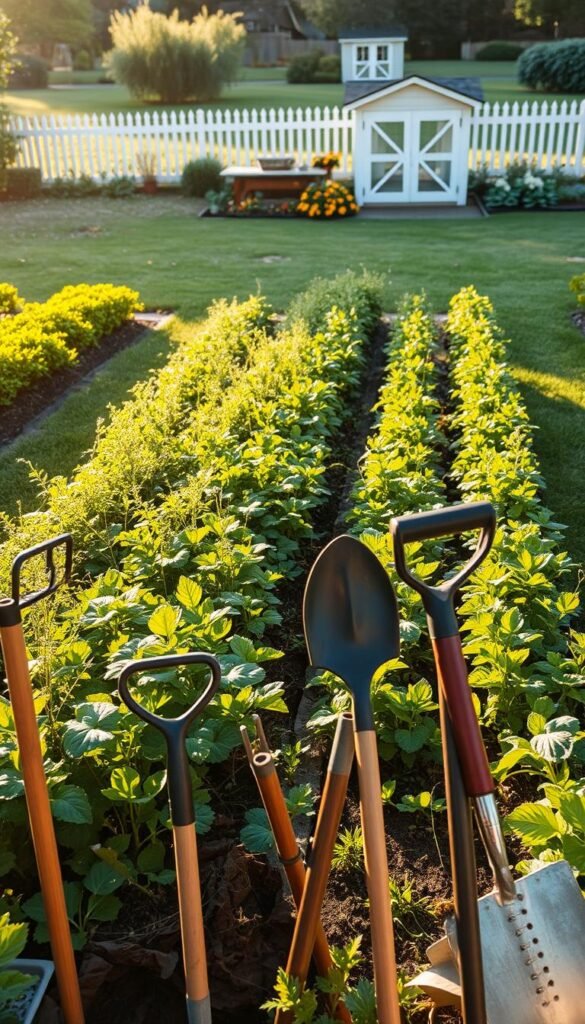
Unwanted plants and pests test every gardener’s patience differently. Your soil handling method directly impacts this battle—whether you’re smothering weeds with natural layers or disrupting their growth cycles. Surprisingly, your choice here may save dozens of hours each season.
Mulch and Cover Crops: Nature’s Weed Blockers
A 3-inch mulch layer cuts weed germination by 75%, acting like a protective blanket for soil. Straw proves especially effective, reducing unwanted growth by 87%. For active suppression, cereal rye as a cover crop inhibits 90% of weeds through natural chemicals.
Living mulches like crimson clover add nitrogen while shading out invaders. Just watch for voles—these rodents sometimes nest in thick mulch layers. The key is balance: enough to suppress weeds but not create pest habitats.
The Hidden Cost of Turning Soil
While tilling seems to eliminate weeds, it brings 12,000 buried seeds per acre to the surface. Each pass creates ideal germination conditions, leading to 40+ weeding hours annually—nearly triple no-till demands.
The initial clean slate comes at a price. Exposed soil loses moisture faster, stressing plant roots. Over time, this cycle demands more herbicides to maintain control.
Working With Nature Against Pests
Reduce chemical reliance with smart combinations. Try this organic spray: mix 1 gallon vinegar, 1 cup salt, and 1 tbsp soap. It works best on young weeds in sidewalk cracks.
“Integrated systems using cover crops and minimal disturbance require 68% fewer herbicide applications within three years.”
Your garden thrives when you disrupt pest cycles naturally. Whether through layered mulch or strategic planting, sustainable methods often solve problems before they start.
Climate Change and Environmental Impact
The way you care for your garden affects more than just plants—it impacts the planet. While debates often focus on yields and labor, the ecological consequences of your soil management choices matter equally. Let’s examine how these methods influence carbon cycles, land preservation, and emissions.
Carbon Sequestration Myths and Facts
Many believe undisturbed soil captures dramatically more carbon than tilled earth. Reality is nuanced—no-till systems store just 3% more carbon annually (0.3 tons/acre) in the first decade. The real advantage emerges over time as organic matter accumulates.
“Long-term no-till fields can store 1.2 tons of carbon per acre yearly after 15 years—equivalent to taking a car off the road for every 10-acre plot.”
Erosion Control: No-Till’s Edge
During a 2-inch rainstorm, tilled plots lose 1 ton of soil per acre—five times more than protected beds. This isn’t just dirt disappearing. Each pound carries nutrients and contributes to water pollution. Undisturbed earth’s natural structure resists washing away while filtering runoff.
Consider these erosion comparisons:
| Condition | Soil Loss (tons/acre/year) |
|---|---|
| Conventional tillage | 5.7 |
| No-till with cover crops | 0.9 |
Fuel Use and Emissions
Traditional tillage emits 42 lbs of CO₂ per acre hourly—like driving 68 car miles. Switching methods cuts this to 12 miles’ worth. Beyond fuel savings, reduced equipment use means fewer compacted soil zones that hinder root growth.
Additional environmental benefits include:
- 65% more beneficial ground beetles (natural pest control)
- 40% less nitrate pollution in waterways
- Improved soil health supporting diverse microorganisms
Your gardening approach becomes part of the climate change solution. Whether through carbon storage or conservation, small choices create measurable differences.
Adapting to Your Climate
Your local weather plays a bigger role in gardening success than you might think. From freezing winters to dry summers, each climate demands tailored strategies. Let’s explore how to match your approach to nature’s rhythms.
No-Till in Cold vs. Warm Regions
Undisturbed soil warms 14 days slower in spring, a challenge in chilly zones like USDA 3–4. Alaskan gardeners combat this with black plastic mulch, trapping heat for early planting. Meanwhile, arid regions (USDA 5–9) see 25% higher yields with no-till thanks to better water retention.
Traditional Tilling for Early-Season Planting
Turning soil accelerates warming, letting you plant crops two weeks earlier in cold climates. Clay soils benefit most—tilling improves drainage by 35%. But beware overworking sandy soils; they need 30% less frequent tillage to avoid erosion.
Rainfall and Soil Type Factors
Areas with under 20 inches of annual rain thrive with no-till’s moisture retention. Humid zones face risks like Southern blight—thick mulch can trap excess moisture. Consider this soil guide:
| Soil Type | Best Method | Tip |
|---|---|---|
| Clay | Traditional (spring) | Add compost to prevent compaction |
| Sandy | No-till | Use rye cover crops for stability |
“Hybrid systems—tilling once every 3 years—boost yields by 18% in transitional climates.”
Your garden isn’t just plants—it’s a partnership with your region’s weather. Test small patches each year to find the right balance for your crops.
Transitioning from Traditional to No-Till
Changing soil management methods isn’t about flipping a switch—it’s a gradual transformation. Your earth needs time to rebuild its natural structure and microbial communities. Expect a 3-year adjustment period where yields might dip 12% initially before surpassing traditional results.
Patience and Soil Recovery Time
Undisturbed soil works at nature’s pace. Beneficial fungi networks take 18-24 months to fully reestablish, while earthworm populations often double within two growing seasons. This biological activity boosts nutrients availability for plant roots over time.
“Transitioning fields show 20% slower initial growth but demonstrate 35% higher drought resilience by year five.”
Steps to Start No-Till Successfully
Begin with these essentials:
- Test your soil pH and add amendments gradually
- Invest in key tools: broadfork, compost spreader, and roller crimper
- Plant daikon radish as a cover crop to alleviate compaction (80% success rate)
For nitrogen deficits, apply soybean meal (6-1-2) at 15 lbs per 100 sq ft. Mustard cover crops help prevent disease carryover through natural biofumigation.
Common Challenges and Fixes
Follow this 5-year timeline for best results:
| Year | Focus Area |
|---|---|
| 1 | pH correction and fungal inoculants |
| 2 | Mineral supplements (rock dust) |
| 3 | Micronutrient refinement (boron, zinc) |
If struggling, a single cautious tillage pass won’t undo progress. Many find success combining no-till techniques with strategic crop rotation. Remember—your garden’s health improves with each undisturbed season.
Making the Right Choice for Your Garden
Finding the best approach for your space depends on several key factors. Start with a soil test—it reveals pH and nutrient needs for just $15-$30. Over time, healthier earth can save $500 per acre in inputs.
Consider your garden size. Small plots often thrive with minimal disturbance, while larger areas may benefit from hybrid systems. Many market growers till vegetable rows but leave perennials undisturbed.
Your local climate matters too. Arid regions gain from water retention, while cold zones might need occasional tillage for early planting. Track microclimates—sunny spots versus shaded corners.
Most gardeners stick with their chosen method after three years. Whether you prioritize quick results or long-term soil health, your plants will flourish with thoughtful care.
Pro tip: Connect with local mentor networks or NRCS programs for tailored advice. Your soil—and future crops—will thank you!






